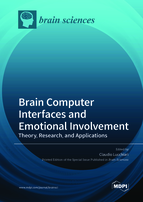Brain Computer Interfaces and Emotional Involvement: Theory, Research, and Applications
A special issue of Brain Sciences (ISSN 2076-3425). This special issue belongs to the section "Computational Neuroscience and Neuroinformatics".
Deadline for manuscript submissions: closed (20 August 2020) | Viewed by 38793
Special Issue Editor
Interests: creativity; learning; cognitive flexibility; decision-making; EEG; tDCS; neuro modulation; neurofeedback; emotions; applied cognitive science; multi-brain neuroscience
Special Issues, Collections and Topics in MDPI journals
Special Issue Information
Dear Colleagues,
Brain–computer interfaces (BCI) are technological systems that enable individuals to interact with a computer using their brain activity. A BCI system can translate brain signals (e.g., electric or hemodynamic brain activity indicators) into a command to execute an action on the BCI application (e.g., a wheelchair, the cursor on the screen, a spelling device or a game).
Applications are now available in various research and clinical fields, such as for communication and control tools for severely disabled users, rehabilitation, and human–computer interaction. These tools have the advantage of having real-time access to the ongoing brain activity of the individual, which can provide insight into the user’s emotional state by training a classification algorithm to recognize affect states. This information can be utilized to analyze the cortical activity in specific areas during complex tasks, as well as to allow the BCI to adapt its recognition algorithms. Furthermore, information about emotional involvement can be used to improve the user’s experience while controlling the BCI through affective modulation.
This Special Issue is dedicated to the study of brain activity related to emotional involvement as measured by BCI systems designed for different purposes. Papers reporting theoretical models, targeted reviews, research, and clinical applications are welcome.
Dr. Claudio Lucchiari
Guest Editor
Manuscript Submission Information
Manuscripts should be submitted online at www.mdpi.com by registering and logging in to this website. Once you are registered, click here to go to the submission form. Manuscripts can be submitted until the deadline. All submissions that pass pre-check are peer-reviewed. Accepted papers will be published continuously in the journal (as soon as accepted) and will be listed together on the special issue website. Research articles, review articles as well as short communications are invited. For planned papers, a title and short abstract (about 100 words) can be sent to the Editorial Office for announcement on this website.
Submitted manuscripts should not have been published previously, nor be under consideration for publication elsewhere (except conference proceedings papers). All manuscripts are thoroughly refereed through a single-blind peer-review process. A guide for authors and other relevant information for submission of manuscripts is available on the Instructions for Authors page. Brain Sciences is an international peer-reviewed open access monthly journal published by MDPI.
Please visit the Instructions for Authors page before submitting a manuscript. The Article Processing Charge (APC) for publication in this open access journal is 2200 CHF (Swiss Francs). Submitted papers should be well formatted and use good English. Authors may use MDPI's English editing service prior to publication or during author revisions.
Keywords
- brain computer interface
- emotional involvement
- brain activity
- human–machine interaction
- emotion detection methods
- artificial intelligence
- rehabilitation
- emotional BCI control
- psychological states







